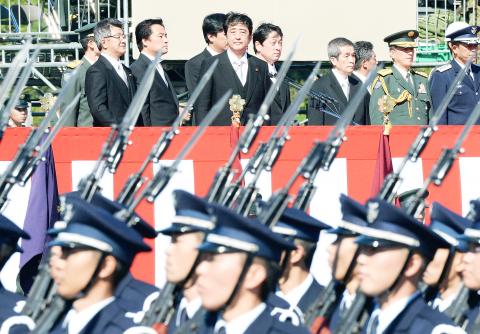|
Abe warns against any use of force
Reuters, ASAKA, Japan

Japanese Prime Minister Shinzo
Abe, top center, inspects troops during a military review at the Japan Ground
Self-Defense Force¡¦s Asaka training ground near Tokyo yesterday.
Photo: AFP
Japanese Prime Minister Shinzo Abe told
Japanese troops yesterday that Japan would not tolerate the use of force to
change the region¡¦s ¡§status quo,¡¨ comments likely to rile Beijing, which is
locked in a long and bitter territorial dispute with Tokyo.
¡§Use of force for changing the status quo¡¨ is an expression often used by
Japanese politicians and security experts to indirectly refer to what they see
as China¡¦s aggressive maritime expansion in the East China Sea and the South
China Sea.
Abe¡¦s comments are the second in as many days in which he has effectively said
Japan is ready to be more assertive toward China.
They came as Chinese military aircraft flew near Japan for a third day in a row,
prompting Tokyo to scramble fighter jets each time.
Abe is seen as a hawkish nationalist who wishes to revise a post-war pacifist
constitution drafted by the US and strengthen Japan¡¦s defense posture.
His comment yesterday, made at an annual troops review, comes after the Chinese
Ministry of Defense warned Japan not to underestimate China¡¦s resolve to take
whatever measures necessary to protect itself.
¡§Development of weapons of mass destruction and ballistic missiles by North
Korea. Provocation against our sovereignty. The security environment surrounding
Japan is getting tougher,¡¨ Abe told the military review, which consisted of
about 3,900 troops, 240 vehicles and 50 aircraft.
¡§In order to show our firm national intention that changing the status quo by
force will not be tolerated, we need to carry out various activities, such as
surveillance and information gathering,¡¨ he said.
In the latest sign of tensions between the region¡¦s two heavyweights, Japan
yesterday scrambled fighter jets after two Chinese bombers and two airborne
early warning planes flew near Japan¡¦s southern islands into the Pacific and
then back into the East China Sea. No violation of Japanese airspace took place.
The same formation of Chinese aircraft made similar flights on Friday and
Saturday.
|
![]()
![]()
![]()